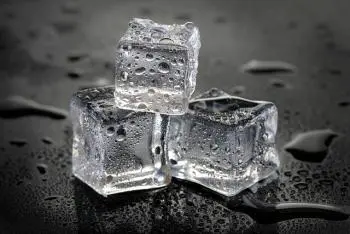
Matter is one of the fundamental concepts in physics and chemistry, and comes in several different states, each with its own unique properties and behaviors.
The states of matter (or aggregation states of matter) are solid, liquid and gaseous, although other states also exist, such as plasma and Bose-Einstein condensate.
In this article, we will explain in detail each of these states and how scientists study them.
Solid state
The solid state is one of the most common states of matter and is one in which the particles that make up a material are strongly bonded to each other. Particles in a solid state do not have a large momentum, which gives them a defined structure.
Solids have a definite shape and volume and are generally incompressible.
The structure of a solid can be crystalline or amorphous. Crystalline solids have an ordered, repeating structure, like a salt crystal or a diamond. Amorphous solids, on the other hand, do not have an ordered structure and examples of this can be glass or plastic.
An interesting property of solids is that their shape and volume do not change easily when subjected to pressure or temperature. This is due to the strong interactions between the particles that compose them. Additionally, solids have the ability to transmit forces, allowing them to maintain their shape.
Liquid state
 Liquids are intermediate states of matter in terms of movement and structure. Unlike solids, particles in a liquid have greater freedom of movement and are not as tightly bound together. This allows them to flow and take the shape of their container.
Liquids are intermediate states of matter in terms of movement and structure. Unlike solids, particles in a liquid have greater freedom of movement and are not as tightly bound together. This allows them to flow and take the shape of their container.
Liquids have a defined volume, but not a fixed shape. This means that a liquid will take the shape of the container it is in. Additionally, liquids are virtually incompressible, meaning their volume does not change significantly under pressure.
Example
A common example of a liquid is water. Water takes the shape of the container it is in, but it always has the same volume in any container. Liquids also have an interesting property called surface tension, which manifests itself in the formation of droplets and capillaries.
gaseous state
 In the gaseous state, the particles of matter have great freedom of movement and are not bound to each other. Gases have no defined shape or volume and expand to completely fill the available space. They can be easily compressed and have a much lower density compared to solids and liquids.
In the gaseous state, the particles of matter have great freedom of movement and are not bound to each other. Gases have no defined shape or volume and expand to completely fill the available space. They can be easily compressed and have a much lower density compared to solids and liquids.
Gases are very sensitive to changes in temperature and pressure, as demonstrated by the gas laws. When a gas is heated, its particles gain kinetic energy and move faster, causing the gas to expand. On the other hand, when a gas cools, its particles lose kinetic energy and move more slowly, causing contraction.
Example
An example of a common gas is the air we breathe. Air is composed mainly of nitrogen and oxygen in a gaseous state and fills the space around it without having a specific shape or volume.
Other states of matter
In addition to the three classical states of matter, there are more exotic states that occur under special conditions. Two of these states are plasma and Bose-Einstein condensate.
Plasma
Plasma is a state of matter that forms at high temperatures, when particles acquire so much energy that electrons separate from the nuclei, creating a sea of free electrons and positive ions. This results in a highly electrically conductive material and is found in natural phenomena such as the sun and stars. It is also created artificially in devices such as fluorescent tubes and plasma televisions.
Plasma is an extremely energetic state of matter and exhibits unique properties, such as the emission of visible light. It is important in the research of nuclear fusion and the generation of energy through fusion processes.
Bose-Einstein condensate
The Bose-Einstein condensate is a state of matter that occurs at temperatures close to absolute zero (-273.15°C). It was predicted by Albert Einstein and Satyendra Nath Bose in the 1920s. In this state, the particles cool so much that they begin to behave as a single collective wave, giving rise to strange quantum phenomena.
The Bose-Einstein condensate is notable for its superfluidity and superconductivity behavior, making it a fundamental area of research in condensed matter physics and quantum theory.
State changes
Transitions between states of aggregation of matter, such as fusion, evaporation, sublimation and condensation, are fundamental physical processes. These changes of state occur when thermal energy is added to or removed from matter.
-
Fusion: It is the change of state from solid to liquid, which occurs when a solid is heated. For example, ice turns into liquid water when heated.
-
Evaporation: It is the change of state from liquid to gas, which occurs when the particles of a liquid gain enough energy to become a gas. An example is water boiling and turning into steam.
-
Sublimation: It is the direct change of state from solid to gas, without passing through the intermediate liquid state. Dry ice, which is solid carbon dioxide, sublimes when heated.
-
Condensation: It is the change of state from gas to liquid and occurs when the particles of a gas lose enough thermal energy to become liquid. This is what happens when steam condenses into water droplets.
Importance in science and technology
States of matter are fundamental in science and technology and have applications in a wide variety of fields. Here are some examples of its importance:
-
Materials and nanotechnology: Essential for designing and creating new materials, including superconductors and nanoscale materials.
-
Energy: Crucial in the production and storage of energy, such as nuclear fusion and Bose-Einstein condensates.
-
Earth sciences and astronomy: Helps understand geological and atmospheric processes, as well as the formation of stars and galaxies.
-
Medicine and life sciences: Important in the cryopreservation of tissues and organs, as well as in medical imaging technology.